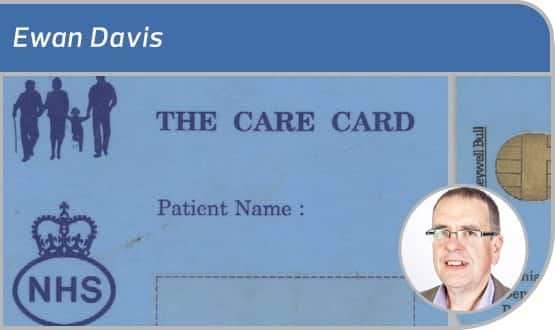Ewan Davis: EPS – is it my fault?

It’s probably my fault. I have been struggling with the Electronic Prescribing Service. I want to get to the point where I don’t have minus five days’ supply of one if my repeat medications and 12 months’ worth of another.
Not that EPS has caused this problem (it was ever thus) but it hasn’t solved it. Yet it should have, and I have this nagging doubt it my fault!
Twenty years ago, in Wales
I’ve tried my best. I’ve worked out when the supply of each of my medicines will run out and I’ve suggested what should go on both of my two monthly repeat scripts over the next six months.
I written this down and faxed it to both my GP and my pharmacy (about a digital as they can manage); but to no avail. It seems that the only way I can avoid running out is to reorder the lot, every time.
I don’t really blame either my GP or pharmacy. The staff in both are lovely and I’m sure they sort it if they could. It’s EPS that is not solving the problem and that may be making it worse. And that brings me back to that nagging feeling that it’s all my fault.
I first worked on what we now call EPS (its earlier name, the Electronic Transfer of Prescriptions or ETP was a much better description of what it actually does) in 1986.
Back then, I was working on a project in Rhydyfelin in South Wales for the-then DHSS (no devolution then). I believe it was the first attempt to pass a prescription between GP and pharmacy in an electronic form (although there was an earlier project which addressed the link between pharmacy and the Prescription Pricing Authority).
The Rhydyfelin project used a memory card and sort of worked, but with no integration into either GP or pharmacy systems was on little practical value.
Ten years ago, in big community pharma
My next engagement with ETP was as a GP system supplier, with the Exmouth Care Card Project. This used a smart card very much like today's chip and pin cards and was integrated into GP, pharmacy, and hospital systems (the card also carried a medical record – the project had wider ambitions) but again went nowhere.
Things went quiet for a while and I next became involved in 1996, when there was an attempt by a start-up, PRS Ltd, to launch a commercial EPS service. This “excited” community pharmacy with the prospect of having to pay 5p per script item delivered to them.
I was working for Gehe UK, which owned both the biggest pharmaceutical Wholesaler (AAH) and the largest retail pharmacy group (lloydspharmacy). They and the other big players multiplied 5p by the 600 million scripts they were processing each year and didn’t like the answer.
This led to a joint industry effort, which I led, to launch a shared service based on the BACS model. We designed and piloted a service looking pretty much the way EPS works today.
However, we were then overtaken by the National Programme for IT, which decided EPS should be one of the three pillars of the programme. It adopted what we had done, which was fine by us as it killed PRS.
But by the time it found out that ETP is not EPS is was too late and too embarrassing to admit it. EPS as we know it today was born. I was the primary architect of the service they adopted; and this is why I worry my medication problems may, in a profound way, be my fault.
Lessons to learn
But, actually I don’t think it is my fault. What we designed in 1996 was about as good as the technology of the day allowed. The problem is that 20 years later the NHS has only just finished rolling it out. So what can we learn from this experience?
Firstly, the biggest problems faced by EPS were not technical, but political. Most of community pharmacy didn’t want change.
It had spent the past 50 years trying to get as physically close to GP practices as it could and persuading itself that mail order pharmacy was illegal, unethical and uneconomic.
EPS made geography history and was a potentially massively disruptive innovation. They didn’t want it and officials were unwilling to rock the boat and disturb their own quiet lives.
EPS was therefore hobbled by technical restrictions and regulation, which castrated its disruptive potential to reduce cost and improve patient service and medicines adherence.
Secondly, progress was glacial with far too much time spent trying to accommodate vested interests and little or no attention to the patient experience. Add to this the protracted procurement and the original design was already well in to obsolescence by the time serious implementation started in the early noughties
Yesterday’s technology, today!
Thirdly, the original design had discounted the idea of patients having online access to the system as impractical. A reasonable view in 1996, with UK internet penetration at 4.1% (and almost certainly much lower amongst those with regular medication).
However, by 2002 it was obvious that with internet penetration approaching 60% we should be building a patient portal. That we are still just talking about a patient portal (and perhaps some apps) to manage EPS in 2016, with internet penetration at 92.6%, tells me there is something very wrong with the system.
Today, we should have an EPS that work like Screwfix or Argos. There, I can place an order and pick up my item at my chosen store in less than five minutes or have it delivered within 24 hours.
I should be able to see what is available, what needs my GP’s authorisation, what’s waiting for me to collect at my chosen pharmacy, and what’s on its way to me by post. I should get reminders that I need to re-order or see my GP in enough time to make sure I don’t run out of supplies; and should have prompts and other support to help my adherence.
I am told that the next iteration of EPS will deliver these things and I guess it will. But I wonder if, by the time it arrives, it will look as obsolete as the current version looks today? Where is the Dash Button for my repeat medication?
Sort of my fault…
I see the same forces at work in other aspects of digital health today. No real appetite for disruptive innovation, the vested interest of incumbents (both in the NHS and amongst vendors) taking priority over patient needs and wishes, pointless regulatory barriers, and procurement processes so slow they can only ever procure obsolescence.
Maybe the current hapless state of EPS is my fault – I’ll leave you to judge. All I ask is that we learn the lesson from it.
About the author:
Ewan Davis is a digital health strategist at Woodcote Consulting, with 35 years experience in digital health. He was once chair of the Primary Health Care Group of the BCS, has twice been chair of the trade association that is now techUK, and is a founder of HANDI – a not for profit venture that aims to promote openness and collaboration and which developed the Code4Health Platform for NHS England.
Ewan is also director of two open source ventures, OpenHealthHub CIC and Synapta CIC, and an erstwhile consultant to the rich and famous and NHS England. He wants to see an open digital ecosystem for health and social care before he dies; and believes that if we create one he might live longer. Follow him @WoodcoteEwan.




